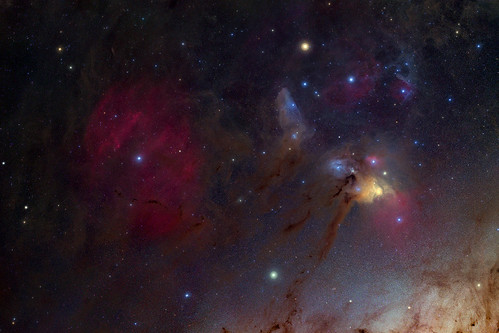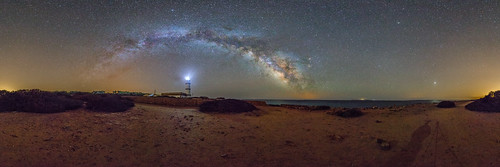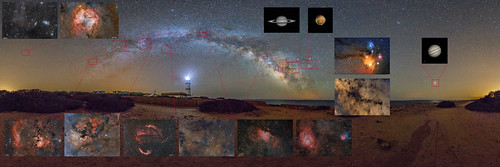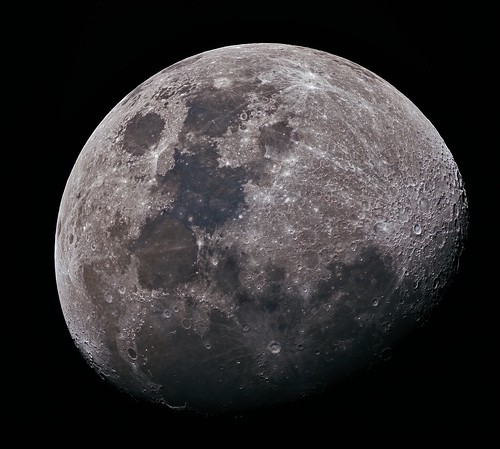Submissions: 2016 April
Re: Submissions: 2016 April
Southern Cross, Eta Carinae & Lambda Centauri
Image info: http://www.astrobin.com/full/245526/0/
Copyright: Kiko Fairbairn https://fbcdn-sphotos-g-a.akamaihd.net/ ... 3836_o.jpg
Image info: http://www.astrobin.com/full/245526/0/
Copyright: Kiko Fairbairn https://fbcdn-sphotos-g-a.akamaihd.net/ ... 3836_o.jpg
Last edited by bystander on Sun Apr 17, 2016 4:45 pm, edited 2 times in total.
Reason: Please, no hotlinks to images > 500Kb. Uploaded as an attachment.
Reason: Please, no hotlinks to images > 500Kb. Uploaded as an attachment.
Re: Submissions: 2016 April
Anasazi Tower
http://www.ancientskys.com
Copyright: Marc Toso
An ancient Anasazi tower found in the canyons of southern Utah. This is two shots blended together. One shot for the milky way and another for the ruin/foreground. The long exposure for the foreground is ~10minutes long.
http://www.ancientskys.com
Copyright: Marc Toso
An ancient Anasazi tower found in the canyons of southern Utah. This is two shots blended together. One shot for the milky way and another for the ruin/foreground. The long exposure for the foreground is ~10minutes long.
Re: Submissions: 2016 April
photographs of sunspot group 2529 ... in the sky? in the water?
solution
http://sohowww.nascom.nasa.gov/data/syn ... s_1024.jpg
https://twitter.com/perezrayego/status/ ... 3711100929
villanueva de la serena, spain. 2016-04-17, 13:00 and 13:07
http://sohowww.nascom.nasa.gov/data/syn ... s_1024.jpg
https://twitter.com/perezrayego/status/ ... 3711100929
villanueva de la serena, spain. 2016-04-17, 13:00 and 13:07
-
Sternfreund
- Ensign
- Posts: 73
- Joined: Wed Feb 25, 2015 12:23 pm
- Location: Near Vienna - Austria
- Contact:
Re: Submissions: 2016 April
Sunspot AR2529
http://www.far-light-photography.at
Copyright: Arno Rottal
Sunspot AR2529
254/1200 Dobsonian with DMK21.04.as
350 frames used. artificial color.
http://www.far-light-photography.at
http://www.far-light-photography.at
Copyright: Arno Rottal
Sunspot AR2529
254/1200 Dobsonian with DMK21.04.as
350 frames used. artificial color.
http://www.far-light-photography.at
Re: Submissions: 2016 April
Cometa C/2013 US10 Catalina - 1 marzo 2016
My last image of Catalina comet.
Location: San Romualdo - Ravenna (Italy)
Tecnosky Apo 130 F/7
ASA DDM60PRO
QSI520wsi cooled -20
Baader CCD RGB filters
RGB: R (13x90), G (13x90), B (13x90)
Acquired with: MaximDL5
Calibrated with bias and dark
Processed with: MaximDL5, Astroart4, Startools1.4, Paint Shop Pro X7 and Topaz plug-in
Cristina Cellini
Location: San Romualdo - Ravenna (Italy)
Tecnosky Apo 130 F/7
ASA DDM60PRO
QSI520wsi cooled -20
Baader CCD RGB filters
RGB: R (13x90), G (13x90), B (13x90)
Acquired with: MaximDL5
Calibrated with bias and dark
Processed with: MaximDL5, Astroart4, Startools1.4, Paint Shop Pro X7 and Topaz plug-in
Cristina Cellini
-
Josh Smith
- Ensign
- Posts: 48
- Joined: Sat Aug 08, 2015 5:01 pm
-
keerthi2kiran
- Asternaut
- Posts: 5
- Joined: Thu Jan 26, 2012 5:15 am
Re: Submissions: 2016 April
The Comet in Ophiuchus
Comet 252P/Linear cruising through Ophiuchus... Captured with almost 40% moon nearby.
Image captured on 3rd April.
Comet 252P/Linear cruising through Ophiuchus... Captured with almost 40% moon nearby.
Image captured on 3rd April.
- geckzilla
- Ocular Digitator
- Posts: 9180
- Joined: Wed Sep 12, 2007 12:42 pm
- Location: Modesto, CA
- Contact:
Re: Submissions: 2016 April
This was posted to the Flickr group, and I thought it was very well done, but I noticed he didn't cross post it here so I am doing it for him.

SF135 Scorpius / Ophiuchus 160418 by Troy Casswell, on Flickr

SF135 Scorpius / Ophiuchus 160418 by Troy Casswell, on Flickr
Just call me "geck" because "zilla" is like a last name.
-
Andromeda 2013
- Science Officer
- Posts: 196
- Joined: Tue Jul 09, 2013 2:11 pm
- Contact:
Re: Submissions: 2016 April
AR2529 Sun Spot
clink on link for zoomable version
https://www.flickr.com/photos/92681330@N06/25830994064/
Copyright: Daniel Pasternak
clink on link for zoomable version
https://www.flickr.com/photos/92681330@N06/25830994064/
Copyright: Daniel Pasternak
-
Bi2L
- Science Officer
- Posts: 103
- Joined: Tue Jul 19, 2011 11:24 am
- AKA: Bill Metallinos
- Location: Corfu, Greece
- Contact:
Re: Submissions: 2016 April
Interstellar matter and dust
Banquet of interstellar dust matter and looking at the internal threads of our galaxy somewhere between Centaur Sagittarius and the powerful Scorpio in the constellation Ophiuchus, where the secular horse galloping our imagination inside the stars.
The main disc of our galaxy has a diameter of 80,000 to 100,000 light-years, the perimeter 250 to 300 000 light years and a thickness of about 1,000 light years. It consists of 200 up to 400 billion stars. If we define a natural scale and assume that the Milky Way has a diameter of 130 km, the solar system would have a length of 2 mm. The Galactic Halo extends over a diameter of 250,000 and 400,000 light years. As reported extensively in the galaxy structure below, new research has shown that the disk extends much more than we thought until last.
Officially, since 2005, the Milky Way is now considered to be a large barred spiral galaxy SBbc type the Hubble sequence (small barred spiral helix) with a total mass of 600 to 3,000 billion solar masses (M☉) [5] [6], comprising from 200 to 400,000,000,000 stars.
The galactic disk has an estimated diameter of about 100,000 light years. The distance of the Sun from the center of the galaxy is estimated at 26,000 light years. The disc is protuberant in the center and symperikleietai from the so-called thick disk.
The Sun (and thus the Earth and the Solar System) is quite close to the inner ring of the Arm of Orion, local cloud, at 7,94 ± 0,42 kpc from the Galactic Center. The distance between the local arm and immediately nearest, the Perseus Arm, is of the order of 1 · 1019 m (6.500 light years). The Sun and by extension the solar system, located in what scientists call the Galactic Habitable Zone.
The direction of the Sun's path (apix or corymb), refers to the direction of the Sun as it travels in the Galaxy. The general direction of galactic motion of the Sun is near the constellation Hercules, at an angle of approximately 86 degrees from the Galactic Center. The orbit of the Sun in the Galaxy is expected to be approximately elliptical with the addition of influences from the galactic arms and uneven mass distribution. We are currently 1/8 of the track before perigalaxio (the shortest distance from the center of the Milky Way).
The solar system takes about 225-250000000 years to complete an orbit (one Galactic Year), so speculation has performed approximately 20-25 orbits during its lifetime. The orbital speed of the Solar System is 217 km / sec, ie. One light-year every 1,400 years, and 1 AU in 8 days.
Canon eos 5D mk2, SW EQ6, EF 85mm f1.2 LII, 85mm f/2.2, Iso800, 13X90sec, DSS
Corfu, Greece
Banquet of interstellar dust matter and looking at the internal threads of our galaxy somewhere between Centaur Sagittarius and the powerful Scorpio in the constellation Ophiuchus, where the secular horse galloping our imagination inside the stars.
The main disc of our galaxy has a diameter of 80,000 to 100,000 light-years, the perimeter 250 to 300 000 light years and a thickness of about 1,000 light years. It consists of 200 up to 400 billion stars. If we define a natural scale and assume that the Milky Way has a diameter of 130 km, the solar system would have a length of 2 mm. The Galactic Halo extends over a diameter of 250,000 and 400,000 light years. As reported extensively in the galaxy structure below, new research has shown that the disk extends much more than we thought until last.
Officially, since 2005, the Milky Way is now considered to be a large barred spiral galaxy SBbc type the Hubble sequence (small barred spiral helix) with a total mass of 600 to 3,000 billion solar masses (M☉) [5] [6], comprising from 200 to 400,000,000,000 stars.
The galactic disk has an estimated diameter of about 100,000 light years. The distance of the Sun from the center of the galaxy is estimated at 26,000 light years. The disc is protuberant in the center and symperikleietai from the so-called thick disk.
The Sun (and thus the Earth and the Solar System) is quite close to the inner ring of the Arm of Orion, local cloud, at 7,94 ± 0,42 kpc from the Galactic Center. The distance between the local arm and immediately nearest, the Perseus Arm, is of the order of 1 · 1019 m (6.500 light years). The Sun and by extension the solar system, located in what scientists call the Galactic Habitable Zone.
The direction of the Sun's path (apix or corymb), refers to the direction of the Sun as it travels in the Galaxy. The general direction of galactic motion of the Sun is near the constellation Hercules, at an angle of approximately 86 degrees from the Galactic Center. The orbit of the Sun in the Galaxy is expected to be approximately elliptical with the addition of influences from the galactic arms and uneven mass distribution. We are currently 1/8 of the track before perigalaxio (the shortest distance from the center of the Milky Way).
The solar system takes about 225-250000000 years to complete an orbit (one Galactic Year), so speculation has performed approximately 20-25 orbits during its lifetime. The orbital speed of the Solar System is 217 km / sec, ie. One light-year every 1,400 years, and 1 AU in 8 days.
Canon eos 5D mk2, SW EQ6, EF 85mm f1.2 LII, 85mm f/2.2, Iso800, 13X90sec, DSS
Corfu, Greece
-
Andromeda 2013
- Science Officer
- Posts: 196
- Joined: Tue Jul 09, 2013 2:11 pm
- Contact:
Re: Submissions: 2016 April
Sun Dog
clink on link for zoomable version
https://www.flickr.com/photos/92681330@N06/26507809686/
Copyright: Daniel Pasternak
clink on link for zoomable version
https://www.flickr.com/photos/92681330@N06/26507809686/
Copyright: Daniel Pasternak
-
Andromeda 2013
- Science Officer
- Posts: 196
- Joined: Tue Jul 09, 2013 2:11 pm
- Contact:
Re: Submissions: 2016 April
AR2529
clink on link for zoomable version
https://www.flickr.com/photos/92681330@N06/26228535250/
Copyright: Daniel Pasternak
clink on link for zoomable version
https://www.flickr.com/photos/92681330@N06/26228535250/
Copyright: Daniel Pasternak
-
Andromeda 2013
- Science Officer
- Posts: 196
- Joined: Tue Jul 09, 2013 2:11 pm
- Contact:
Re: Submissions: 2016 April
Moon
clink on link for zoomable version
https://www.flickr.com/photos/92681330@N06/26501385345/
Copyright: Daniel Pasternak
clink on link for zoomable version
https://www.flickr.com/photos/92681330@N06/26501385345/
Copyright: Daniel Pasternak
-
Andromeda 2013
- Science Officer
- Posts: 196
- Joined: Tue Jul 09, 2013 2:11 pm
- Contact:
Re: Submissions: 2016 April
Moon
clink on link for zoomable version
https://www.flickr.com/photos/92681330@N06/25898528563/
Copyright: Daniel Pasternak
clink on link for zoomable version
https://www.flickr.com/photos/92681330@N06/25898528563/
Copyright: Daniel Pasternak
-
Andromeda 2013
- Science Officer
- Posts: 196
- Joined: Tue Jul 09, 2013 2:11 pm
- Contact:
Re: Submissions: 2016 April
M-51 Whirlpool Galaxy
clink on link for zoomable version
https://www.flickr.com/photos/92681330@N06/26243402100/
Copyright: Daniel Pasternak
clink on link for zoomable version
https://www.flickr.com/photos/92681330@N06/26243402100/
Copyright: Daniel Pasternak
-
Andromeda 2013
- Science Officer
- Posts: 196
- Joined: Tue Jul 09, 2013 2:11 pm
- Contact:
Re: Submissions: 2016 April
Messier 106 Galaxy
Messier 106 is a spiral galaxy in the constellation Canes Venatici. It was discovered by Pierre Méchain in 1781. M106 is at a distance of about 22 to 25 million light-years away from Earth.
clink on link for zoomable version
https://www.flickr.com/photos/92681330@N06/26282363081/
Copyright: Daniel Pasternak
Messier 106 is a spiral galaxy in the constellation Canes Venatici. It was discovered by Pierre Méchain in 1781. M106 is at a distance of about 22 to 25 million light-years away from Earth.
clink on link for zoomable version
https://www.flickr.com/photos/92681330@N06/26282363081/
Copyright: Daniel Pasternak
-
Andromeda 2013
- Science Officer
- Posts: 196
- Joined: Tue Jul 09, 2013 2:11 pm
- Contact:
Re: Submissions: 2016 April
AR2529
clink on link for zoomable version
https://www.flickr.com/photos/92681330@N06/26162982820/
Copyright: Daniel Pasternak
clink on link for zoomable version
https://www.flickr.com/photos/92681330@N06/26162982820/
Copyright: Daniel Pasternak
-
David_Forteza
- Ensign
- Posts: 14
- Joined: Thu May 01, 2014 1:09 pm
Re: Submissions: 2016 April
Milky Way & Labels:
34 panoramic images, all in an exposition, without tricks or traps.
Credits:
David Forteza (panorama image)
Raul Villaverde, Xisco A, José Jiménez (images of deep sky and planetary)
Copyrights:
David Forteza
 A la sombra de la Via Lactea by David Forteza, en Flickr
A la sombra de la Via Lactea by David Forteza, en Flickr
 Mosaico by David Forteza, en Flickr
Mosaico by David Forteza, en Flickr
34 panoramic images, all in an exposition, without tricks or traps.
Credits:
David Forteza (panorama image)
Raul Villaverde, Xisco A, José Jiménez (images of deep sky and planetary)
Copyrights:
David Forteza
 A la sombra de la Via Lactea by David Forteza, en Flickr
A la sombra de la Via Lactea by David Forteza, en Flickr Mosaico by David Forteza, en Flickr
Mosaico by David Forteza, en FlickrRe: Submissions: 2016 April
solutionRothkko wrote:photographs of sunspot group 2529 ... in the sky? in the water?
solution
http: //sohowww.nascom.nasa.gov/data/syn ... s_1024.jpg
https: //twitter.com/perezrayego/status/ ... 3711100929
http://sohowww.nascom.nasa.gov/data/syn ... 160417.jpg
https://twitter.com/perezrayego/status/ ... 3711100929
-
Hung-Hsuan Yen
- Ensign
- Posts: 45
- Joined: Wed Jan 25, 2012 8:15 am
Re: Submissions: 2016 April
Jupiter v.s. ISS
Date: 2016.4.21 19:14:02(GMT+8)
Location: Miaoli County, Taiwan(24.3929, 120.6706)
Optics: GSO 16" DOB
Camera: ASI120MC
Exposure: 0.00063 sec
Copyright: Hung-Hsuan Yen
https://www.facebook.com/redscosky
Location: Miaoli County, Taiwan(24.3929, 120.6706)
Optics: GSO 16" DOB
Camera: ASI120MC
Exposure: 0.00063 sec
Copyright: Hung-Hsuan Yen
https://www.facebook.com/redscosky
-
Julien QUIRIN
- Asternaut
- Posts: 4
- Joined: Fri Apr 22, 2016 7:20 pm
Clavius ; Longomontanus
Explanations (in French) : http://astro.julienquirin.fr/Observatio ... s_2016.htm
Re: Submissions: 2016 April
M97 re-processed picture 2016-2014, ~10 hours in total exposure
http://www.astro-hp.dk/28096428
http://www.cloudynights.com/topic/45633 ... ula/page-2
http://www.astrobin.com/users/nvcchr1/
Copyright: Niels V. Christensen
http://www.astro-hp.dk/28096428
http://www.cloudynights.com/topic/45633 ... ula/page-2
http://www.astrobin.com/users/nvcchr1/
Copyright: Niels V. Christensen
Night in Atacama Desert
http://astronomiapampeana.com.ar/
Copyright: Leonardo Julio
Copyright: Leonardo Julio






